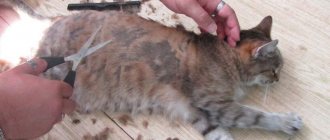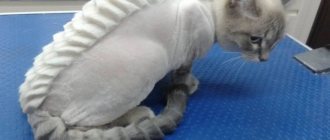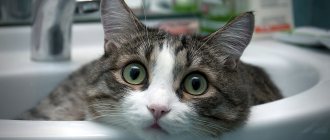Kittens really don't like water treatments. For them, water is associated with something scary and unpleasant. But no one canceled washing, because this is the key to cleanliness and health. It is better to accustom your kitten to water from an early age. So, he will get used to the procedure and love bathing. But in order for this process to take place in peace and comfort, you should take care of the bathing rules in advance. So how to wash a kitten correctly?
The advisability of bathing
Many people do not understand why bathe a kitten if nature has endowed it with a rough tongue with which it washes itself. Of course, a rough tongue helps kittens take care of their fur and remove small particles of dirt from their bodies. Kittens can spend several hours licking themselves. And this is justified. After all, wild cats carefully lick themselves before the hunt to obscure their own scent. So, hunting brings results.
Why are kittens afraid of water? It is known that cats are heat-loving animals. But when their fur coat, which protects them from the cold, gets wet, the kittens lose their ability to retain heat and freeze. Pets that are always warm and have weakened immune systems begin to get sick. Also, an inappropriate choice of shampoo will result in allergies, dry skin, hair loss and brittleness for the kitten.
Some especially love to swim and get into the water themselves, but this happens in rare families.
Then in what cases should you bathe a kitten?
- The fur was covered with a greasy coating.
- Accumulations of dirt and stickiness are visible on the skin.
- Wool has an unpleasant odor.
- Fleas.
- If the kitten is very dirty and licking becomes dangerous.
- If a purebred kitten has no fur.
Washing my cat according to all the rules: algorithm
Let's consider a detailed algorithm for bathing a cat if it is afraid of water and scratches, in order to do everything correctly. Then washing will only bring benefits.
Instructions:
- First of all, prepare the bathroom. Remove all unnecessary objects, things that the animal can catch or drop.
- Prepare a towel, shampoo, and massage mitten in advance.
- Remember that it is important to hold your cat firmly. It’s great if you have an assistant: when one person fixes the cat, and the other carefully washes it, it’s much more convenient.
- Wet the cat's coat. Maintain normal water temperature: it should be warm, but not scalding.
- To start, use a moderate amount of shampoo. There is no need to use too much as this will make the bath longer. Lather a small amount (about a capful) and spread it over the entire coat with a mitten.
- No need to soap your face! The cat does a great job of cleaning himself. You need to make sure that shampoo and water do not get into the animal’s ears or eyes. You can even cover your ears with cotton swabs.
- Carefully direct the stream of water from the shower: it is advisable to wash in the direction of the fur. Water should not flow directly into the muzzle or under the tail. Try to pour mostly onto your back, and then rinse off, gently driving off the water with a mitten, distributing the moisture throughout your body.
- Rinse the shampoo from top to bottom. Rinse the fur thoroughly so that no shampoo remains on it, because the cat will then lick itself.
- Once all the shampoo has been rinsed off, you can finish bathing. Immediately carefully wrap the animal in a large soft towel. The cat will be happy to sit and dry out in such a cocoon.
Washing should take 10-15 minutes. Try not to delay bathing.
Contraindications to bath procedures
There are also contraindications in which bathing a kitten is strictly prohibited. In such cases, it is better to wipe the coat from above with a damp cloth.
- Quarantine and vaccination. If your kitten is undergoing a two-week quarantine or has already been vaccinated, do not bathe him under any circumstances until this period is over.
- Lichen. A dangerous disease that concentrates in one place, and if you completely bathe the kitten, it can spread throughout the entire skin.
- Illness and operations. If your little pet is sick, no matter what disease, it is better to refrain from bathing until he has fully recovered.
- Stress. During times of stress, it is better not to expose the kitten to even greater stress, otherwise the small animal’s nervous system will definitely not be able to withstand it.
Have pity on your pet and do not expose it to even greater danger.
And some more tips on washing cats
- Do not bathe a pregnant cat or if she is nursing kittens.
- An adult, unneutered cat needs more frequent washing. Due to the secretion secreted, his fur gets dirty faster, becomes greasy and sticks together.
- At least two weeks must pass after the operation, and only then can the animal be bathed.
- If you adopted a pet from a shelter, you should not wash it in the first few days. Moving and swimming together is incredibly stressful.
- During the shedding period, washing helps to quickly get rid of dead hairs.
- Do not wash your animal while it is sick.
So, the frequency of bathing is a conditional indicator. It depends on the cat’s cleanliness, the characteristics of its lifestyle and conditions of detention. An attentive owner will always understand that his pet needs additional care and will carry out water procedures with maximum comfort. For professional haircuts and grooming, we recommend going to a pet salon.
At what age can you bathe a kitten?
Veterinarians do not recommend bathing a kitten until 3 months old, since during this period their skin glands are just forming. If the protective secretions are washed off from the skin, the kitten may develop dermatitis. In the first month, the kitten is calmly licked by its mother. Subsequently, he learns to do it himself and this will be enough for him.
Already after three months of age, if the kitten knows its owners and trusts them, you can bathe the animal for the first time. You don’t have to put this procedure aside. It is better for a kitten to get used to water at an early age.
If a kitty or cat has gotten very dirty, but they have not yet learned to lick themselves, you can wipe the dirty areas with a damp cloth.
Begin washing with awareness and confidence so that your cat feels your love for him.
Choice of product
For little fluffies, you usually buy shampoo with a liquid consistency.
It is important not only to bathe the kitten correctly, but also to choose the right shampoo for it. According to consistency, hygiene care products are of the following types:
- Liquid. Most often used. These are special pet shampoos and conditioners that clean the coat of dirt and make combing easier.
- Powdery. They are preferred by cat owners who are afraid of water to the point of panic. The powder effectively removes remaining dirt and secretions, but the product is not suitable for kittens with dark fur coats.
- Sprays. After application, all contaminants are easily removed, in addition, the product helps fight tangles.
Bathing frequency
But you shouldn’t immediately run out and wash your pet almost every day. Such a frequent procedure will not benefit the kitten. With frequent bathing, the coat deteriorates and the skin becomes dry.
Domestic kittens should be washed 2-4 times a year. For example, you can wash your pet once every quarter (3 months).
If your kitten goes for walks outside, or you go out with him periodically, then after each walk you should definitely wash his paws. Well, general bath procedures should be carried out 6-10 times a year.
For hairless kittens, bath procedures are considered almost the basis of everything. Since their skin is not protected by fur, it secretes a secretion that quickly begins to spread an unpleasant odor, and such kittens get dirty faster. Therefore, such kittens are washed approximately once a month.
Also, veterinarians recommend bathing a kitten once in winter and autumn, and twice in spring and summer.
Do not neglect the health of your pet; take washing with great responsibility. The main thing is not to go through this procedure frequently.
How to wash a cat
The condition of the animal's skin is greatly influenced by what you bathe the cat with. This should be a special pet shampoo that best suits the type and length of the coat.
Breeders recommend professional products. Their advantages:
- no flavorings;
- natural composition;
- improve the quality of wool and allow you to wash away dirt well.
If there is no special shampoo and the cat needs to be washed, in exceptional cases and once it is permissible to use shampoo for children under 3 years of age.
Is it possible to wash a cat with regular shampoo?
Cats have drier skin than humans. Therefore, you cannot bathe a kitten or an adult animal with either baby soap or human shampoo. Using regular shampoo will dry it out, which may result in hair loss.
You should also not wash your cat with laundry soap. The product changes the state of the microflora of the skin and dries it out. From such experiments, the coat becomes dry, dull, and allergies may develop.
Shampoos for other animals are not suitable either. Detergents, for example, for dogs can cause serious allergies in cats even after the first use.
How to prepare for washing
Before starting bath procedures, it is important to prepare in advance for such a serious event. The main thing when washing a kitten is not to scare it, so that it does not experience unpleasant sensations when it comes into contact with water.
General recommendations to follow include:
- Close the door tightly and avoid drafts.
- Trim your pet's nails and brush them beforehand.
- To begin, add water 10 cm from the bottom. Then add, but not above the shoulders.
- The water temperature should be between 35-40 degrees.
- Do not bathe your kitten immediately after eating. About 4 hours must pass before you can take bath procedures.
The main thing is that the fluffy does not participate in the preparatory process.
Most of all, kittens are afraid of the sound of water from a tap or shower. Therefore, it is not recommended to turn them on while your pet is near you.
Selection of hygiene products
There is a huge selection of pet wash products on the market. Such shampoos are distinguished both by skin type and consistency. But kittens need gentle products and they need products that are specifically designed for them. It is worth consciously approaching the choice of shampoo with which you will wash your kitten.
- Liquid shampoos will make your kitten's fur soft and fluffy. This product foams quickly, so only a small amount of shampoo is needed.
- Dry shampoos are not used with water, so the kitten must be dry. Shampoo is applied to the skin and combed off along with the dirt.
- Sprays are also used on dry skin.
- Special shampoos are aimed at combating problems and have the desired effect. Such shampoos fight parasites, and there are also medicinal ones for damaged kitten skin.
Never use the shampoos that we humans use to wash our hair. For animals, such products are very aggressive.
Inventory
Prepare in advance everything you will need when washing your kitten.
- Veterinarians do not recommend bathing kittens in the bathtub as it is too big for them. It is better to prepare a special bath for bathing children and a ladle.
- Towels and rags. You will need towels to dry the kitten after the bath, and place a rag on the bottom of the bath to make it more comfortable for the kitten to stand.
- Place shampoo, small washcloths, and toys next to the basin.
- To protect your head and ears, you can purchase special hats and earplugs.
- For calm incubation of all procedures, you can buy a special net for bathing for the kitten. This way he won’t run away and won’t scratch you.
With such a combat set, you will definitely be 100% ready to bathe your pet. Just don’t forget to call someone for help to be on the safe side. Washing your pet is much easier with two people.
There are special caps for washing kittens, nets and fastenings.
Causes of fear
Fear and aversion to water is a natural cat reaction.
Your pet can and should be bathed. The cause of fear is caused by many factors. This may be an unusual environment, too bright light, noise and shouting of people.
Situation
In the bathroom, the animal's movements are constrained, sounds seem sharp, and the sound of water is frightening. Often the owner shouts at the cat if it behaves too aggressively.
The animal does not like that in the bathroom it cannot gain stability, clinging to its claws, while being forcibly held down.
Reaction to shower and hot water
Water flows out of the shower spray noisily and in large streams, which greatly frightens your pet. The animal perceives the hissing pressure of water as a living aggressive creature.
Fluid temperature is not always adjusted (too cold or too hot). When swimming, these factors should be taken into account first.
Bathing a kitten - how the procedure works
The most common bathing is done with liquid shampoo, so use that. How to bathe a kitten correctly and without harm:
- Place the kitten in a bath that is already filled with water at about 40 degrees. The kitten must reach the bottom and not drown. Grab the kitten by the scruff of the neck. So, he will not have the opportunity to flounder and scratch. Calm the baby, talk to him, praise him.
- First, wet his fur with a ladle. Do not wet your ears and head - it is better to avoid getting water in these places. You can take a shower instead of a ladle, but only if the kitten is not afraid of the stream that runs from there.
- Pour a small amount of shampoo onto your hand and rub between your palms. It is important that the foam has already formed on your palms, this makes it easier to apply it to the wool. Apply shampoo to the back, paws, tummy, and tail. Don't touch your head or ears.
- Take a washcloth designed specifically for your pet and gently soap your cat. Distribute the foam in all places. Pay special attention to the pads on the paws, genitals, armpits, chin, neck. A lot of dirt accumulates in these places, because they are difficult for the kitten to reach. Wash off dirt thoroughly.
- The most unpleasant thing is washing your hair, so we postponed this item to the very last. Using a washcloth, gently wet your head and ears.
Carefully! Water should not get into the eyes and ears, as the pet may experience inflammatory processes.
- Lather your hair, also carefully, massage lightly. You only need a little foam on your head.
- Now you can wash it off. Using a shower or a ladle, water the kitten from top to bottom, that is, from head to tail. There should be no foam left, all fur should be clean, otherwise the kitten may be poisoned by hygiene products when licking itself.
- Place the kitten in a warm, terry towel. Let him warm up a little in this towel. Take a second towel and blot all areas so that no water remains.
What will you need to bathe your cat?
If you have already decided to give your cat a bath, but she is afraid of water and scratches, it is important first of all to stock up on everything you need and be well prepared:
- Shampoo. Pay special attention to shampoo. You need to choose animal shampoo for bathing, and not use your own. You can use regular cat degreasing shampoo. It will provide basic coat care. It is also advisable to use a special cleansing paste: it is applied to the most problematic areas before washing. Some people also choose texturizer shampoos, which add shine and volume to the coat and make combing easier. Long-haired cats need such formulations.
- Latch. A very useful modern invention will allow you to limit your cat’s physical activity in the bathroom. The accessory is a special collar with a cord that has a suction cup at the end. It is attached to the bathtub so that the animal does not escape from the bathtub. It will be able to move, but it will no longer be able to jump out of the room. An excellent solution for anyone who doesn’t want to chase a scared, wet cat throughout the apartment.
- Massage mitten. You can wash the animal by hand, but this is inconvenient and ineffective. It is much better to take a special massage mitten. With its help, it is much easier to distribute the shampoo throughout the coat, rub it in thoroughly, and then rinse well along with the dirt.
- Towels. After bathing the cat, you need to dry it well so that it does not leave wet marks behind and does not catch a cold. It is advisable to use at least two large towels. The first will become the base - the main moisture will be absorbed into it. But with the help of a second towel you can dry the animal’s coat more thoroughly. Proper drying will quickly restore the cat’s normal thermoregulation.
How to bathe correctly for the first time
It is important that after its first wash the kitten has only pleasant memories. Therefore, carry out your bath procedure in comfort and coziness. For kittens who are trying to wash their coat for the first time, you should follow all the rules described above. And also adhere to the following tips.
Cheer up your four-legged friend.
- Introduce the kitten to the bathtub or basin. Show him the tap, the water. Also bring his toys, perhaps he will be calmer with them.
- For the first time, use unscented shampoos.
- It is better to wash a kitten for the first time not alone, but with someone. So, another person will hold and pinch the ears while you wash the kitten.
- Gently soap the kitten with a sponge and rinse off the foam thoroughly.
- Wrap the kitten in a warm towel and sit with it for about 10 minutes. Later, take another dry towel and wrap it again. Place the kitten in a warm place: a bed or a house.
- After washing, treat your purr with something tasty to make him feel better.
If the kitten is against
It also happens that a kitten is categorically against any water. Perhaps the kitten has bad memories creeping in, or water for him is an association of something terrible. But in order to solve such a problem, you should show patience and love for your baby.
Before washing, play with the kitten. During the game he will relax a little and get tired. This way he won’t have the strength to fight water wars in the bathtub.
The main thing is not to feed the kitten before the bath procedure.
While you put the kitten in the water, distract him with toys. There is no need to throw the kitten into the water, do everything smoothly and continuously.
If you still fail to wash your kitten, the only solution is dry shampoo or spray. Or wipe the wool with a damp cloth or napkin. So, you will not expose the kitten to water, but simply clean it with dry shampoo.
Do not shout or scold under any circumstances. Talk calmly and kindly to the kitten, praise it, laugh quietly and play.
Dry shampoo is the way out
So, the owner decided that bathing the cat is an objective necessity, but the animal does not let itself be handled, bites, scratches and protests against water procedures in every possible way. What to do?
The way out is to use dry shampoo. Even though the effect of such a procedure is not comparable to the cleanliness after washing, treating the fur with this product gives cats less discomfort than bathing.
The powder from the bottle is applied to the animal’s fur coat directly with your hands, making massaging movements with your fingers. After this, so that the product is distributed evenly, the pet is combed. There is no need to wash off the powder with water.
It is important to take precautions when working with dry shampoo. Firstly, the procedure should be carried out in a room where the floors can be washed (it is almost impossible to remove spilled cleaning powder from the carpet without damaging the latter). Secondly, use the product no more than once every six months. Otherwise, the animal will develop an allergic reaction to the shampoo. This leads to a logical disappointing conclusion: dry cleaning products are not a panacea, and sooner or later the cat will have to be washed in the traditional way.
Breed characteristics and bathing
There are additional bathing instructions for different breeds. There is also an individual approach to washing, because everyone’s character and genes are different.
- The Scots and British wash themselves very carefully. And they take care of their fur many times better than others. Therefore, such kittens can be washed twice a year.
- Long-haired Siberian and Persian kittens, as well as fold-eared ones, are washed six times a year. Before washing, you should comb the coat thoroughly.
- Since the fur of white kittens is subject to more contamination, they can be washed with shampoos that are aimed at whitening.
- Sphynxes and other hairless kittens are washed only with special shampoos designed for their breed. I don’t wash my hair, but wipe it with napkins. After washing, be sure to rub with baby cream, but so that the kitten does not lick it off.
- Burmese kittens should be wiped daily with a damp cloth and bathed only if they are very dirty. This is because this type of breed has very thin and short hair.
Before bathing your pet, you should learn more about the characteristics of your cat.
Can cats be washed with regular shampoo?
If a pet suddenly appears in the house, the question arises: can it be washed with regular shampoo, which is available?
The answer to this question is unequivocal and negative. You cannot wash cats with regular shampoo that people use. Even if it's a super-healthy and expensive shampoo.
First, human hair and cat hair products have different pH levels. The balance of the animal's skin will be immediately disturbed, which may lead to the development of skin and immune diseases.
Secondly, fragrances and dyes included in “human” shampoos cause allergies and asthma in animals.
Thirdly, what makes human hair clean and smooth can harm a cat's fur. It will become dull, lifeless, and begin to shed.
If we talk about soap, it is also unacceptable when washing cats. Frankly speaking, it is not recommended for humans to wash their hair with soap, and even less so for cats. It will completely dry out the skin and cause hair loss.
To wash animals, you can use products designed strictly for this purpose. They are balanced, have the correct suitable composition and do not harm the skin, respiratory tract and fur of animals.
Drying your pet
The moment has come when it's time to dry. The main thing is to immediately wrap the kitten in a towel after washing so that there is no risk of getting sick. There are two types of drying:
- Leave the kitten in a warm room for 12 hours so that all the fur dries on its own. The kitten will take care of drying itself and will begin to lick itself for a long time. After all, he has special scales on his tongue that remove excess moisture.
- Blow drying is possible if the kitten is not afraid of this scary sound. Blow-drying is also better for long-haired kittens, as their fur takes longer to dry than usual and they need a little help. The main thing is to comb the coat while drying. It is recommended to dry with warm air so as not to burn or freeze your pet.
The main thing is to avoid open windows and drafts. Do not let the kitten outside while drying. Kittens are very prone to infections if their coats are wet.
Expert advice
Bathing is a simple process that requires patience. And if you approach this with all your heart, the procedure will be fun. Bathe the kitten correctly, without causing him any unpleasant sensations, then he will get used to it and will not be afraid of water.
In conclusion, experts recommend using a couple more tips.
- It is best to bathe a kitten during shedding. So, the excess hair will go away, and the kitten will not be able to swallow some of the hairs that contain harmful substances when licking.
- If the kitten has already gotten very dirty somewhere, for example, in oil, then before bathing you should lubricate this area with butter and blot it with a paper napkin.
- If your kitten has fleas, it is important to use a specialized shampoo. Therefore, first, start washing the kitten from the neck so that while washing the body, fleas do not run to the head.
Choose exceptionally soft and comfortable towels for your pet.
How to bathe if a cat is afraid of water?
While bathing, the cat will most likely cling to everything, trying to escape. To make the process go smoothly, we will give some tips on how to wash a cat that is afraid of water:
Bathing a afraid cat
- First, skip the shower and wash and rinse only with a ladle.
- Secondly, do not fill the washing container with water in his presence: most cats are afraid of the noise of running water.
- Thirdly, let him stand on his hind legs and rest his front legs against the side of the bathtub/sink - this way he will partially “control” the process.
And, of course, tenderness, patience and affection are the main helpers in bathing. If water procedures are not possible at all due to the aggressiveness of the animal, then seek help from a veterinarian. Experts know how to properly wash nervous animals.











